Main Menu
Welcome


Bert Hölldobler's topic is ants and he does know his ants! What a great talk! Some of the content of the talk was familiar , from when Bert Hölldobler still was at the University of Würzburg, where I studied. It was from his lectures back then where learned a large part of what I know about evolution. During the talk, I tried to take some pictures of the slides with the ants. Some of them turned out pretty good for being shot from projected images:
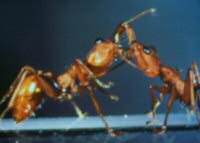
Ants communicate both on a one-on-one basis and en masse. In the latter case, ant use phermones. Hölldobler: "ants are walking batteries of pheromone glands". "Pheromones often not only release behaviors but also act as identifiers". He goes on to describe the amazing structures used to disperse pheromones, for instance the intricate morphology of the pygidial gland with which some ant species mark their trails.
He then describes the recruitment behavior of scouts after they returned to their colony after having laid the trail from the prey item (in the case of this particular species a termite mound).
Another gland some ant species use sits in the legs and they drag their legs to deposit long lasting orientation trails which the animals use to come back to the colony after a raid.
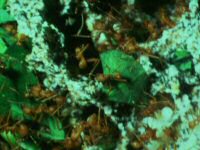
Bert then turned towards leaf cutter ants. These ants cut leaves, transport them to their nest, grow fungi on them and then eat the fruits of the fungi. These ants travel up to 300m to get their leaves and lay down trails to be able to find back to their colony. These trail pheromones constitute a world record: one of them is so powerful that 1mg of it could be used to lay an effective rail six times around the earth. On one particular tree, some leaves get cut while others don't. How do the animals decide which leaves to cut and which ones to leave alone? Apparently, the animals which first start cutting a leaf stridulate on this leaf to call in their close-by nest-mates to help them cut the leaf to pieces. This only works if the branches of the tree are either all maerked with the trail pheromone or not at all. If only one branch of several is marked with pheromone, the pheromone signal is stronger than the stridulation and all the ants go to the pheromone scented branch and leave the stridulating, non-pheromone branch alone. Another function of the stridulation is to attract a caste of ants which hitchhike on the leaves to protect the carriers of the leaves from parasitic flies:
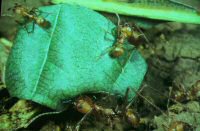
Oecophylla ants also are masters of chemical communication. For instance, discharging their mandibular gland during an attack on a prey animal quickly recruits many conspecifics to help with the attack. These are the species which build their colonies by glueing together leaves to a nest. They are very aggressive against members of other nests. These animals use a territorial pheromone from a specialized rectal gland to mark their home range. "No other ant is so territorial."
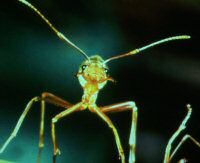
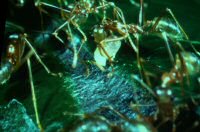

As a final example, Bert was telling us about a species in Arizona, the honey ants. These ants have a caste which just stores honey, hanging from the ceiling of their underground nest. Unfortunately, the picture I took from the honey-pots was all blurry and unusable. These animals only defend the piece of their territory where they are currently fighting termites. In such territorial fights, it may happen that one colony raids the other, stealing all their honey-pots. They even transfer pupae to their nest to have the ants hatching from these pupae work for their colony (slavery?). Several colonies in an area may form hierarchies by small display fights among themselves in so-called tournaments. The colonies fight among themselves and somehow figure out which of them is the strongest one. This remains stable for some time, but if one colony becomes too small and weak, it gets raided. Apparently, there is a specialized caste of ants involved which runs between tournament and colony to recruit more fighters if needed. Weak colonies have a strategy to prevent raids: they can retreat into their nest and block the entrance with stones and debries.
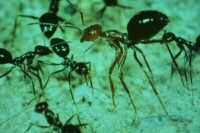


But what Bert Hölldobler didn't tell us is that ants love Rammstein:

Posted on Tuesday 09 September 2008 - 21:27:14 comment: 0
{TAGS}
{TAGS}
You must be logged in to make comments on this site - please log in, or if you are not registered click here to signup
Render time: 0.0774 sec, 0.0048 of that for queries.





